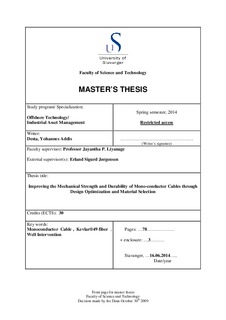| dc.description.abstract | As it is known, different maintenance and rehabilitation activities are conducted in oil & gas wells so as to ensure optimal flow rate, recovery volume, well safety and integrity. In doing all these activities, well intervention companies are highly dependent on the performance and reliability of wireline cables. However, senior technical people at Altus Intervention (formerly called Aker Well Service) have identified the presence of a miss-match between the performance of the currently available wireline cables (specially the 5/16″ - monoconductor cable) and the demand of a well intervention task as wells goes deeper, deviated, and acidic. For these reasons, the company has initiated this project work so as to look for the improvement potential of the currently used monoconductor cables.
In order to pinpoint the limitations of the currently used cables, I have conducted a thorough discussion with senior technical people at Altus Intervention, extracted relevant information and data from the company’s Synergy page, participated in different wireline training courses, and also conduct relevant literature review. Overall, the inherent limitations of the currently used 5/16″ cables are found to originate from their limited strength, relatively heavy weight, integrity of the insulation material, and poor H2S resistance of the steel (high strength version) armor. Moreover, operational related problems such as gas breakthrough, development of kinks and bird nesting, and also the cost of corrosion resistance grades of the cable are found to be leading problems. Thus, formulating a new design approach so as to address these limitations either fully or partially was the main theme of this project work.
In an attempt to solve these limitations, I have used a new design approach which effectively combines high strength Kevlar®49 fiber with abrasion resistance and electrical conducting steel armor wire. The new approach is found to have a higher prospect towards reducing the cable weight, improving the breaking strength, fatigue life, and alleviating short circuiting and other common problems of the currently used 5/16"- monoconductor cables. Furthermore, the conformance of the new concept cable to the harsh well environment, working condition, and operational demand of the well intervention task is also investigated using scientific data, mathematical modeling, software simulation, and other techniques.
Though all the results found are highly encouraging, I strongly recommend the development of a prototype cable and undertake all the relevant tests so as to review the conformance of the new cable to the actual working condition. Developing a tailored inspection technique for this concept cable and also extending the concept towards other cable grades are identified as continuation works of this project work. Furthermore, the possibility of finding non-steel based but abrasion resistance materials so as to fully replace the entire armor wire is also sighted as possible and fascinating research topic as this further helps to reduce the cable weight. | nb_NO |
